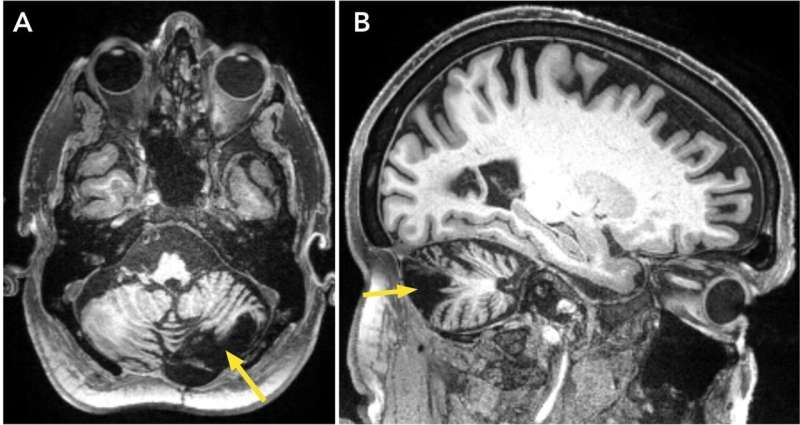This article has been reviewed according to Science X's editorial process and policies. Editors have highlighted the following attributes while ensuring the content's credibility:
fact-checked
trusted source
proofread
Case report shows promising results using transcranial magnetic stimulation for post-stroke ataxia

In a new case report, researchers at UCLA Health describe promising results using repetitive transcranial magnetic stimulation (rTMS) in the management of post-stroke cerebellar ataxia, a debilitating condition marked by impaired coordination and balance.
Cerebellar ataxia describes a group of neurological disorders that affect coordination, balance, and control of muscle movements. It results from damage or dysfunction of the cerebellum, a part of the brain responsible for coordinating voluntary movements. Ataxia can manifest as unsteady walking, difficulties with fine motor skills, and problems with speech, among other symptoms. The severity of ataxia can vary from mild to severe, and treatments often aim to manage symptoms and improve a person's quality of life as treatment options are limited.
Writing in The Cerebellum, researchers led by Evan Hy Einstein, Department of Psychiatry & Biobehavioral Sciences at the UCLA David Geffen School of Medicine, report on the case of a 58-year-old male who had experienced a cerebellar hemorrhage approximately 12 years previously.
Despite intensive rehabilitation, symptoms such as slow and unsteady gait, balance issues, and urinary incontinence persisted over the years. The patient sought consultation for potential rTMS treatment. His primary complaints focused on his slow and unsteady gait, along with challenges related to balance and stability. The decision was made to employ bilateral cerebellar rTMS, representing an innovative approach to address the condition.
Over five daily sessions, the patient underwent rTMS targeting both the right and left cerebellar hemispheres. The patient reported subjective improvement after just two days of stimulation. By the fifth day, there were noticeable improvements. The patient's walking speed increased from 0.57 m/s to 0.60 m/s, and his balance improved, as measured by the Berg Balance Scale, which rose from 27 to 38.
More significantly, the patient was able to rise from sitting unaided and was able to bend to pick up a pencil from the floor easily. He reported improved balance and stability in that he could stand unaided and without using hand supports while performing activities of daily living in the bathroom (e.g., showering and shaving), which he was unable to do prior to treatment.
"This case represents the first instance of bilateral cerebellar rTMS used to treat post-stroke cerebellar ataxia," said Dr. Einstein. "Further research is warranted to ascertain long-term clinical benefits and explore the underlying neural mechanisms of this innovative treatment, but It underscores the potential of tailored treatment protocols that consider the specific etiology of ataxia."
More information: Evan Hy Einstein et al, Bilateral Cerebellar Repetitive Transcranial Magnetic Stimulation for Chronic Ataxia After Hemorrhagic Stroke: a Case Report, The Cerebellum (2023). DOI: 10.1007/s12311-023-01618-1




















